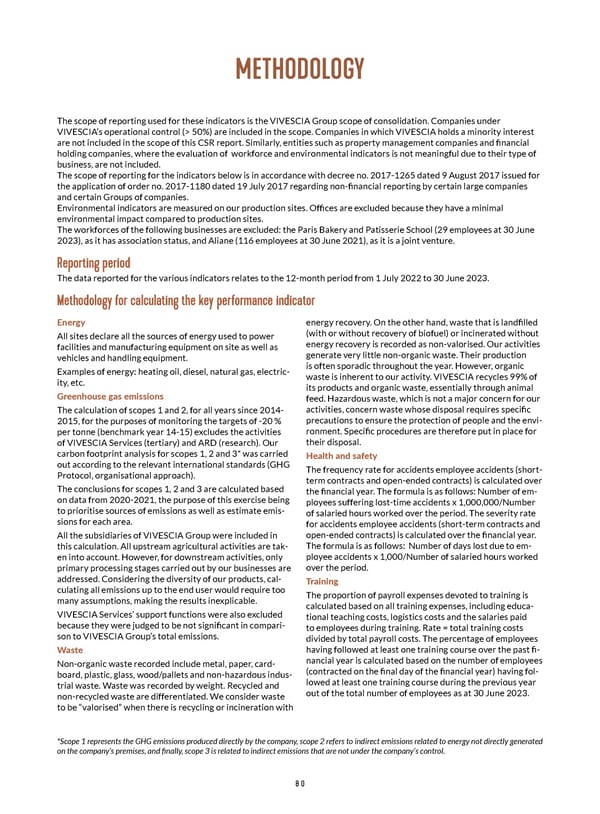GOING DEEPER METHODOLOGY The scope of reporting used for these indicators is the VIVESCIA Group scope of consolidation. Companies under VIVESCIA’s operational control (> 50%) are included in the scope. Companies in which VIVESCIA holds a minority interest are not included in the scope of this CSR report. Similarly, entities such as property management companies and 昀椀nancial holding companies, where the evaluation of workforce and environmental indicators is not meaningful due to their type of business, are not included. The scope of reporting for the indicators below is in accordance with decree no. 2017-1265 dated 9 August 2017 issued for the application of order no. 2017-1180 dated 19 July 2017 regarding non-昀椀nancial reporting by certain large companies and certain Groups of companies. Environmental indicators are measured on our production sites. Of昀椀ces are excluded because they have a minimal environmental impact compared to production sites. The workforces of the following businesses are excluded: the Paris Bakery and Patisserie School (29 employees at 30 June 2023), as it has association status, and Aliane (116 employees at 30 June 2021), as it is a joint venture. Reporting period The data reported for the various indicators relates to the 12-month period from 1 July 2022 to 30 June 2023. Methodology for calculating the key performance indicator Energy energy recovery. On the other hand, waste that is land昀椀lled (with or without recovery of biofuel) or incinerated without All sites declare all the sources of energy used to power energy recovery is recorded as non-valorised. Our activities facilities and manufacturing equipment on site as well as generate very little non-organic waste. Their production vehicles and handling equipment. is often sporadic throughout the year. However, organic Examples of energy: heating oil, diesel, natural gas, electric- ity, etc. waste is inherent to our activity. VIVESCIA recycles 99% of Greenhouse gas emissions its products and organic waste, essentially through animal feed. Hazardous waste, which is not a major concern for our The calculation of scopes 1 and 2, for all years since 2014- activities, concern waste whose disposal requires speci昀椀c 2015, for the purposes of monitoring the targets of -20 % precautions to ensure the protection of people and the envi- per tonne (benchmark year 14-15) excludes the activities ronment. Speci昀椀c procedures are therefore put in place for their disposal. of VIVESCIA Services (tertiary) and ARD (research). Our carbon footprint analysis for scopes 1, 2 and 3* was carried Health and safety out according to the relevant international standards (GHG Protocol, organisational approach). The frequency rate for accidents employee accidents (short- term contracts and open-ended contracts) is calculated over The conclusions for scopes 1, 2 and 3 are calculated based the 昀椀nancial year. The formula is as follows: Number of em- on data from 2020-2021, the purpose of this exercise being ployees suffering lost-time accidents x 1,000,000/Number to prioritise sources of emissions as well as estimate emis- of salaried hours worked over the period. The severity rate sions for each area. for accidents employee accidents (short-term contracts and open-ended contracts) is calculated over the 昀椀nancial year. All the subsidiaries of VIVESCIA Group were included in this calculation. All upstream agricultural activities are tak- The formula is as follows: Number of days lost due to em- en into account. However, for downstream activities, only ployee accidents x 1,000/Number of salaried hours worked primary processing stages carried out by our businesses are over the period. addressed. Considering the diversity of our products, cal- Training culating all emissions up to the end user would require too The proportion of payroll expenses devoted to training is many assumptions, making the results inexplicable. calculated based on all training expenses, including educa- VIVESCIA Services’ support functions were also excluded tional teaching costs, logistics costs and the salaries paid because they were judged to be not signi昀椀cant in compari- to employees during training. Rate = total training costs son to VIVESCIA Group’s total emissions. divided by total payroll costs. The percentage of employees Waste having followed at least one training course over the past 昀椀- Non-organic waste recorded include metal, paper, card- nancial year is calculated based on the number of employees board, plastic, glass, wood/pallets and non-hazardous indus- (contracted on the 昀椀nal day of the 昀椀nancial year) having fol- trial waste. Waste was recorded by weight. Recycled and lowed at least one training course during the previous year non-recycled waste are differentiated. We consider waste out of the total number of employees as at 30 June 2023. to be “valorised” when there is recycling or incineration with *Scope 1 represents the GHG emissions produced directly by the company, scope 2 refers to indirect emissions related to energy not directly generated on the company’s premises, and 昀椀nally, scope 3 is related to indirect emissions that are not under the company’s control. 80
 Integrated Report VIVESCIA Group | July 2022 - June 2023 Page 81 Page 83
Integrated Report VIVESCIA Group | July 2022 - June 2023 Page 81 Page 83